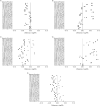Conducting Privacy-Preserving Multivariable Propensity Score Analysis When Patient Covariate Information Is Stored in Separate Locations
- PMID: 28399565
- PMCID: PMC5391702
- DOI: 10.1093/aje/kww155
Conducting Privacy-Preserving Multivariable Propensity Score Analysis When Patient Covariate Information Is Stored in Separate Locations
Abstract
Distributed networks of health-care data sources are increasingly being utilized to conduct pharmacoepidemiologic database studies. Such networks may contain data that are not physically pooled but instead are distributed horizontally (separate patients within each data source) or vertically (separate measures within each data source) in order to preserve patient privacy. While multivariable methods for the analysis of horizontally distributed data are frequently employed, few practical approaches have been put forth to deal with vertically distributed health-care databases. In this paper, we propose 2 propensity score-based approaches to vertically distributed data analysis and test their performance using 5 example studies. We found that these approaches produced point estimates close to what could be achieved without partitioning. We further found a performance benefit (i.e., lower mean squared error) for sequentially passing a propensity score through each data domain (called the "sequential approach") as compared with fitting separate domain-specific propensity scores (called the "parallel approach"). These results were validated in a small simulation study. This proof-of-concept study suggests a new multivariable analysis approach to vertically distributed health-care databases that is practical, preserves patient privacy, and warrants further investigation for use in clinical research applications that rely on health-care databases.
Keywords: database linkage; database studies; databases; epidemiologic methods; pharmacoepidemiology; propensity scores.
© The Author 2017. Published by Oxford University Press on behalf of the Johns Hopkins Bloomberg School of Public Health. All rights reserved. For permissions, please e-mail: journals.permissions@oup.com.
Figures




Similar articles
-
Multivariable confounding adjustment in distributed data networks without sharing of patient-level data.Pharmacoepidemiol Drug Saf. 2013 Nov;22(11):1171-7. doi: 10.1002/pds.3483. Epub 2013 Jul 23. Pharmacoepidemiol Drug Saf. 2013. PMID: 23878013
-
Multivariate-adjusted pharmacoepidemiologic analyses of confidential information pooled from multiple health care utilization databases.Pharmacoepidemiol Drug Saf. 2010 Aug;19(8):848-57. doi: 10.1002/pds.1867. Pharmacoepidemiol Drug Saf. 2010. PMID: 20162632 Free PMC article.
-
Privacy-preserving Statistical Query and Processing on Distributed OpenEHR Data.Stud Health Technol Inform. 2015;210:766-70. Stud Health Technol Inform. 2015. PMID: 25991257
-
Bias in pharmacoepidemiologic studies using secondary health care databases: a scoping review.BMC Med Res Methodol. 2019 Mar 11;19(1):53. doi: 10.1186/s12874-019-0695-y. BMC Med Res Methodol. 2019. PMID: 30871502 Free PMC article.
-
Use of disease risk scores in pharmacoepidemiologic studies.Stat Methods Med Res. 2009 Feb;18(1):67-80. doi: 10.1177/0962280208092347. Epub 2008 Jun 18. Stat Methods Med Res. 2009. PMID: 18562398 Review.
References
-
- Platt R, Carnahan RM, Brown JS, et al. . The US Food and Drug Administration's Mini-Sentinel program: status and direction. Pharmacoepidemiol Drug Saf. 2012;21(suppl 1):1–8. - PubMed
-
- Califf RM. The Patient-Centered Outcomes Research Network: a national infrastructure for comparative effectiveness research. NC Med J. 2014;75(3):204–210. - PubMed
-
- Oliveira JL, Lopes P, Nunes T, et al. . The EU-ADR Web Platform: delivering advanced pharmacovigilance tools. Pharmacoepidemiol Drug Saf. 2013;22(5):459–467. - PubMed
-
- Trifirò G, Coloma PM, Rijnbeek PR, et al. . Combining multiple healthcare databases for postmarketing drug and vaccine safety surveillance: why and how. J Intern Med. 2014;275(6):551–561. - PubMed
-
- Curtis LH, Weiner MG, Boudreau DM, et al. . Design considerations, architecture, and use of the Mini-Sentinel distributed data system. Pharmacoepidemiol Drug Saf. 2012;21(suppl 1):23–31. - PubMed
MeSH terms
Grants and funding
LinkOut - more resources
Full Text Sources
Other Literature Sources

